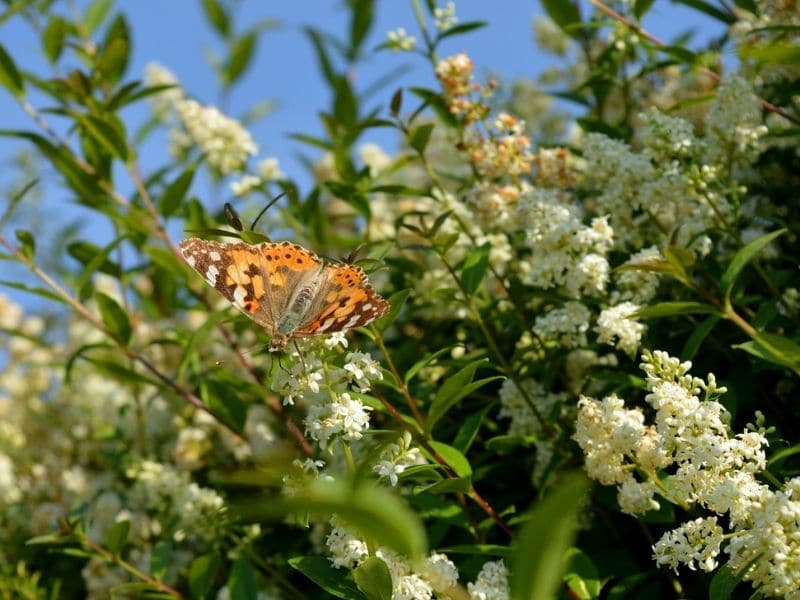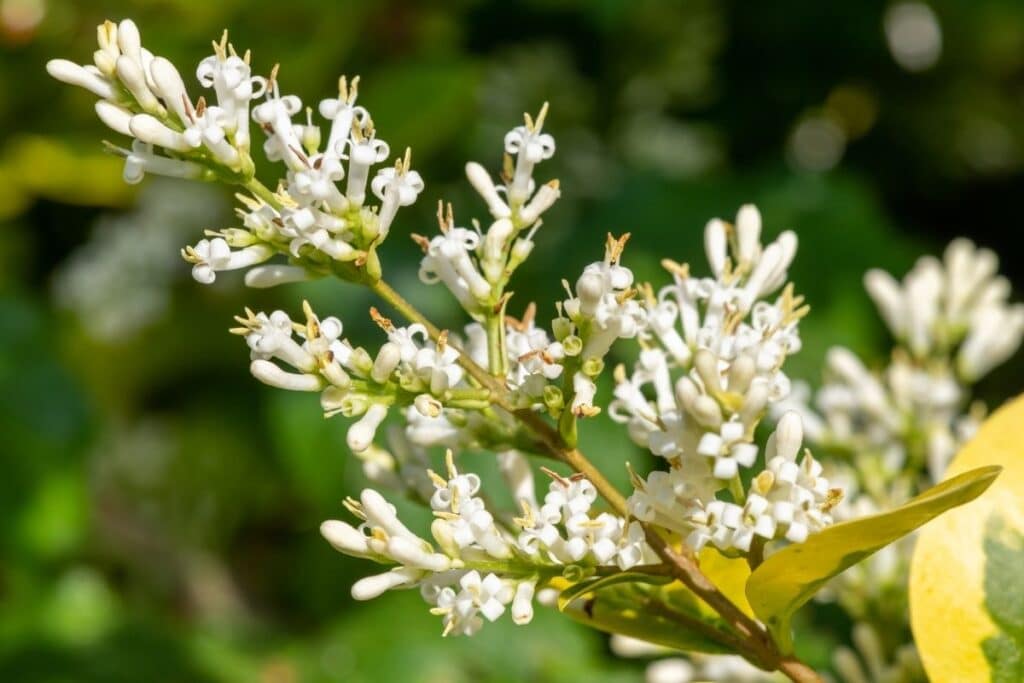Ligustrum plants, or privets as they are often known, are popular garden plants that come with one major disadvantage. These plants have proven to be highly invasive where they are grown outside of their native range.
Fortunately, not all species are equally invasive and at least one seedless cultivar has been developed to solve this problem.
Read on to learn how to grow and care for these fast-growing shrubs and small trees.
What Is A Ligustrum Plant?
Ligustrum is a genus of about 50 species of flowering plants of the Oleaceae family. These plants, which are popularly known as privets, can be either evergreen or deciduous and grow as shrubs and small trees.
The size of these plants varies depending on their species but most of the popular gardening species are large shrubs. Privets are native to North Africa, Europe, Asia, and northern Australia where they can be found in a variety of habitats.
Ligustrum Flowers
Most privet plants produce abundant clusters of white to creamy white flowers and most flowering occurs in late spring. These flowers give way to masses of black berries which are often a showy feature of these evergreen shrubs. These berries are fairly popular with birds that spread the seeds widely.
Ligustrum flowers are fragrant and the smell can vary depending on the plant and its species. Most have a strong sweet fragrance which some people enjoy and some may find unpleasant.

Privet Varieties
There are several Ligustrum species that are popular in the horticultural trade. Some of the best-known species are introduced below:
Vicary Privet (Ligustrum x vicaryi ‘Golden Ticket’)
‘Golden Ticket’ is a seedless Ligustrum, that is the only truly non-invasive privet option available. These plants do flower, but will not produce viable seeds.
Golden privet is a compact form that can be grown as a shrub of 6 feet (1.8 m) or so. It has golden foliage and produces small white flowers.
These adaptable plants should be grown in full to partial sun and will do well in a variety of soil types. ‘Golden Ticket’ is an easy-to-grow, brightly colored hedge plant for zones 5 to 8.
Amur Privet (Ligustrum amurense)
This plant is a popular variety among the Privet species, valued for its adaptability and ornamental features. This deciduous shrub is known for its dense, glossy foliage, which turns a vibrant purple-red in the fall, adding aesthetic appeal to gardens.
Amur Privet is often used in mass plantings or as a hedge or screening plant due to its rapid growth and ability to form a thick, green barrier. It is relatively low-maintenance, tolerant of various soil conditions, and produces small, fragrant white flowers in late spring, further enhancing its overall attractiveness.
Common Privet (Ligustrum vulgare)
Common privet is a deciduous shrub that is native to Europe, West Asia, and North Africa. It reaches a height and spread of 15 feet (4.5 m) and produces masses of white flowers in midsummer. Their flowers have a strong odor and occur in panicles of 2 to 3 inches (5 to 7.5 cm) long.
These flowering shrubs tolerate partial shade to full sun and thrive in mediumly moist, well drained soil. European privet is not a very ornamental species but is useful as a hedge in cooler climates from zones 4 to 7. Unfortunately, this plant has become invasive in some areas.
Glossy Privet (Ligustrum lucidum)
This large East Asian evergreen species usually reaches up to 20 feet (6 m) tall and wide. Like a tree, however, the glossy privet can grow much larger, reaching a height of 40 feet (12 m). The characteristic, large glossy leaves grow to 6 inches (15 cm) long.
This plant flowers in late summer to early fall and produces masses of cream-white flowers. It is a beautiful plant that, sadly, has become invasive in many areas of the United States and should not be cultivated there. Elsewhere, the glossy privet makes a fine hedge or small tree for warm climates. It grows best in full sun to partial shade.
Japanese Privet (Ligustrum japonicum)
L. japonicum is a Japanese and Korean evergreen species that reaches a height of about 12 feet (3.6 m) and produces cream-white flowers in the early summer. It is a fast-growing privet species that has a variety of uses, from privet hedges to topiary and large containers.
This species prefers dry to moderately moist, well draining soil and grows best in full sun to partial shade in USDA hardiness zones 8 to 10. Japanese privet is a hardy plant that can grow by 2 feet (0.6 m) per year and is less invasive than others due to the berries being less attractive to birds.
Chinese Privet (Ligustrum sinense)
Chinese privet grows to a height of about 13 feet (4 m). These fast-growing shrubs are available in a variegated form and make a fine hedge, although the flowers may have an unpleasant fragrance.
They are also attractive and ornamental enough to make great specimen plants. Unfortunately, this species has become invasive in the Southeast of the United States and should not be cultivated there.
California Privet (Ligustrum ovalifolium)
Despite their common name, these plants are not native to the USA and do in fact grow wild in Eastern Asia. They are also known as the Korean privet, garden privet, or oval-leaf privet. This is a very fast-growing semi-evergreen that makes a good hedge but requires a lot of maintenance.
These plants reach about 15 feet (4.5 m) tall. Unfortunately, these plants self-seed readily and can be difficult to control. California privet grows well in coastal areas and is able to survive exposure to salt spray.
How To Grow Privet Plant
Ligustrum trees are fast and easy plants to grow. Seeds taken from ripe berries germinate well when planted in the fall. Older seeds that have dried out should be coldly stratified for 2 months to improve their germination rate.
These bare root plants are easily grown from cuttings and usually take 3 to 6 weeks to root. When propagated in this way, new plants take about 3 years to reach a decent size. To propagate new plants by cuttings, cut 2 to 4 inch (5 to 10 cm) long softwood or sem-ripe cuttings at the nodes and keep two pairs of leaves and root directly in pots.
A root hormone powder will improve success rates and speed the process but is not strictly necessary. Being such vigorous and fast-growing plants, cuttings of up to 2 feet tall (0.6 m) long can root successfully.
These plants grow in a wide range of soil types ranging from very dry, to very wet, depending on the species. The best growth will be possible in moist soil and be sure to keep the plants watered for their first 2 years or so until established.
Hardiness will naturally vary depending on which species you grow but most will grow best in partial shade to full sun conditions.
Privet Shrub Care and Maintenance
In areas where they are invasive, the best way to manage privet is to keep it well pruned to limit flowering and fruit production as much as possible.
These are fast-growing plants that may require frequent pruning to keep them neat. When growing variegated forms, look out for wild-type branches without variegated foliage and remove them.
These privet shrubs can be susceptible to fungal diseases like leaf spot, canker, root rot, and pests like whiteflies.
Ligustrum Uses
Horticultural Uses
Plant privet to create great hedges, ornamental shrubs, and small trees in areas where they are not invasive. These are fast-growing plants that take well to pruning, making them a fine choice for formal hedges and topiary. Ligustrum hedge is very fast growing.
Human Uses
Some species of Ligustrum have been reported as medicinal plants although great care should be taken as others have toxic properties.
Wildlife Uses
Birds eat the berries of these plants and the larval stages of butterflies and moths feed on the foliage.
FAQs
Why is it called a privet hedge?
The term “privet hedge” comes from the use of the privet plant, specifically various species in the Ligustrum genus, for creating hedges. “Privet” itself is derived from the Latin word “privatus,” meaning private, as these hedges were often used to create private enclosures or boundaries.
Is privet poisonous to humans?
Privet plants are generally considered mildly toxic to humans if ingested. The dark green leaves and berries contain substances that can cause stomach upset, nausea, and other symptoms. It’s advisable to avoid consuming any part of the broadleaf shrubs and to exercise caution, especially if there are young children or pets around.
Conclusion
For gardeners looking for a vigorous and fast-growing hedge or small specimen tree, Ligustrums have a lot to offer. Unfortunately, their high maintenance needs and potential for invasiveness means there are often better alternatives to this plant. See our list of many other shrubs to grow.
References
Reference List:
Mikowski, D. A. & Stein, W. I. Ligustrum: The Woody Plant Seed Manual
Toogood, A. Plant Propagation: The Fully Illustrated Plant-By-Plant Manual Of Practical Techniques
Kluepfel, M., Polomski, B. & Williamson, J. Ligustrum.
https://hgic.clemson.edu/factsheet/ligustrum/
Close
*image by [email protected]/depositphotos







